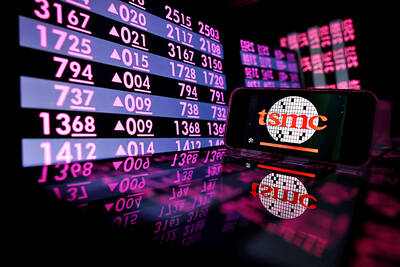China’s central bank yesterday cut a key policy interest rate, in a surprise move to boost the country’s flagging economy.
The People’s Bank of China said it was lowering the seven-day reverse repo rate to 1.9 percent from 2 percent, the first such move since August last year.
The seven-day reverse repo is the short-term interest paid by the central bank on loans from commercial lenders, and a decrease in the rate is expected to increase domestic money supply and stimulate spending.

Photo: AFP
Analysts had predicted monetary easing measures in the coming weeks, but in the form of a cut to the required reserve ratio — the amount of cash banks are required to hold — rather than a rate cut, Capital Economics Ltd economist Julian Evans-Pritchard wrote in a note.
The cut reveals “growing concerns among policymakers about the health of China’s recovery,” Evans-Pritchard wrote.
Chinese authorities have announced a series of lackluster economic indicators in the past few months, pointing to a slowdown in the country’s post-COVID-19 recovery.
Consumer prices rose only 0.2 percent year-on-year last month, while factory activity shrank last month for the second consecutive month.
Beijing has kept interest rates low compared with other major economies, but the near-zero inflation highlights challenges faced by policymakers as they try to stimulate growth.
China’s six largest state-owned commercial banks cut interest rates for savers on Thursday to boost spending, according to announcements on their Web sites, after being asked by the central bank.
Nomura Holdings Inc chief China economist Ting Lu (陸挺) said yesterday’s cut means the central bank would “almost surely deliver” cuts to other key interest rates, the one-year medium-term lending facility rate and the loan prime rate, later this month.

Taiwan Semiconductor Manufacturing Co (TSMC, 台積電) yesterday said that its investment plan in Arizona is going according to schedule, following a local media report claiming that the company is planning to break ground on its third wafer fab in the US in June. In a statement, TSMC said it does not comment on market speculation, but that its investments in Arizona are proceeding well. TSMC is investing more than US$65 billion in Arizona to build three advanced wafer fabs. The first one has started production using the 4-nanometer (nm) process, while the second one would start mass production using the

A TAIWAN DEAL: TSMC is in early talks to fully operate Intel’s US semiconductor factories in a deal first raised by Trump officials, but Intel’s interest is uncertain Broadcom Inc has had informal talks with its advisers about making a bid for Intel Corp’s chip-design and marketing business, the Wall Street Journal reported, citing people familiar with the matter. Nothing has been submitted to Intel and Broadcom could decide not to pursue a deal, according to the Journal. Bloomberg News earlier reported that Taiwan Semiconductor Manufacturing Co (TSMC, 台積電) is in early talks for a controlling stake in Intel’s factories at the request of officials at US President Donald Trump’s administration, as the president looks to boost US manufacturing and maintain the country’s leadership in critical technologies. Trump officials raised the

‘SILVER LINING’: Although the news caused TSMC to fall on the local market, an analyst said that as tariffs are not set to go into effect until April, there is still time for negotiations US President Donald Trump on Tuesday said that he would likely impose tariffs on semiconductor, automobile and pharmaceutical imports of about 25 percent, with an announcement coming as soon as April 2 in a move that would represent a dramatic widening of the US leader’s trade war. “I probably will tell you that on April 2, but it’ll be in the neighborhood of 25 percent,” Trump told reporters at his Mar-a-Lago club when asked about his plan for auto tariffs. Asked about similar levies on pharmaceutical drugs and semiconductors, the president said that “it’ll be 25 percent and higher, and it’ll

CHIP BOOM: Revenue for the semiconductor industry is set to reach US$1 trillion by 2032, opening up opportunities for the chip pacakging and testing company, it said ASE Technology Holding Co (日月光投控), the world’s largest provider of outsourced semiconductor assembly and test (OSAT) services, yesterday launched a new advanced manufacturing facility in Penang, Malaysia, aiming to meet growing demand for emerging technologies such as generative artificial intelligence (AI) applications. The US$300 million facility is a critical step in expanding ASE’s global footprint, offering an alternative for customers from the US, Europe, Japan, South Korea and China to assemble and test chips outside of Taiwan amid efforts to diversify supply chains. The plant, the company’s fifth in Malaysia, is part of a strategic expansion plan that would more than triple